Extinction #2 : The Woolly Mammoth, a journey to the Ice Age and a piece for the African Elephant
Amongst the gaints of the ice age was the woolly mammoth, an animal known for its coat, having hairs which were quite long, tusk curved, only for their population to begin on the decline about 40,000 years ago, this decline hit them hard 10,000 years ago and approximately 4,000 years ago, they met their final demise, it's so unfortunate they are now extinct, it's Extinction #2
This article was brought to you in conjunction with our partner Mechanic Assistant and celeb examiner
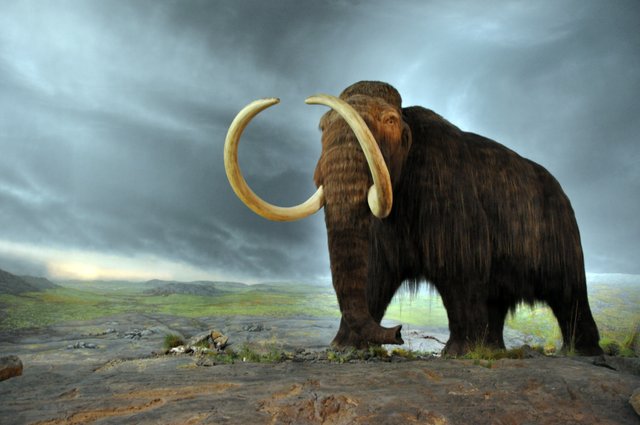
Wikimedia: The Woolly Mammoth Author, Flying Puffinuploaded by FunkMonk Licensed under CC BY-SA 2.0
Its so nice to have you here again for the second issue on this, and today we have the woolly mammoth on the spotlight, all bones and frozen specimen actually, (who wants to see some bones) it's now time to analyze all these specimens to have a picture of the woolly mammoth and how Surviving on earth was like for them and lastly finding and a possible reason for their extinction.
Also we will have a quick look at its relative which is currently on a decline on the road to join them in the land of the extinct, now depending on us to save them from that road, what's going to be of them?, now unto it..
The Woolly Mammoth - Physical Features
With regards to description, the wooly mammoth have its full grown male to measure about 2.7-3.4 metres in height and it's weight is about 6 tonnes, it's female size ranges from 2.6-2.9 m and their weight is less than that of the male of about 4 tonnes, comparison with related living specie (the elephant) insinuated that a calf of a wooly mammoth would have weighed 90kg.
From information gotten from caves arts of the woolly mammoth in the Rouffignac Cave in France, it was noticed that the wooly mammoth was built for the cold mostly with respect to the nature of its fur which is seen in almost all parts of its body, other adaptation for the cold is its ears which when compared to that of the elephants is quite smaller, they measure about 38 centimeters long, and about 18 to 28 centimeters across, it's tail is also seen to be short measuring about 36 centimeters.
The wooly mammoth features a sloping back, a large and doomed head having a hump at its shoulder, this sees an animal which reduces in size with respect to its back vertebrate moving from the front to the rear end, although this was different in the juveniles as they are seen to have a convex back which looks like that seen in a modern elephant.
The cave paintings also discovered and confirmation from the frozen specimen of the wooly mammoth discovered showed that it had a different trunk when compared to the elephants having an upper finger just at tip of its trunk with a pointed lobe which measures 10 centimeters and a lower thumb about 5 centimeters. When it's trunk was examined it was noticed to have a fleshy expand at one third of is length such that it becomes ellipsodal in shape rather than the oval nature of other parts with dimension twice that of other sections.
From all animals of the Prehistoric age, the woolly mammoth is said to be well known to us since it has so many of its specimen discovered having soft tissues ad they were found frozen.
It's Coat
The woolly mammoth's coat makes it a spectacular animal, the coat is seen to have an outer guard hair which varies in length across its body, at the upper part, it measures about 30 centimeters while it's flank and underside have hairs to measure around 90cm and diameter about 0.5 millimeters. Its underwool is curly measuring about 8 centimeters long.
The upper part of the leg have hair to measure about 38 centimeters and its feet hairs is seen to measure about 15 centimeters which it maintained down to its toes, it's head coat had short hairs but gets longer moving down the underside of its trunk, it's tail is filled with coarse hair which are quite thick and long such that it extends the tail to about 60 centimeters.
Suggestion was that the woolly mammoth might have been among animals who moulted seasonally, shedding it's fur seasonally during the spring.
Dentition
The tusk of the woolly mammoth is more curved than an elephant, a big male woolly mammoth tusk measures about 4.2 meters in length and it's weight is about 91kg, a more typical size of the woolly mammoth tusk measures from 2.4-2.7 m having an approximate weight of 45kg, for the female, its tusk is thinner and smaller on the average measuring about 1.5-1.8 meters and weigh about 9kg.
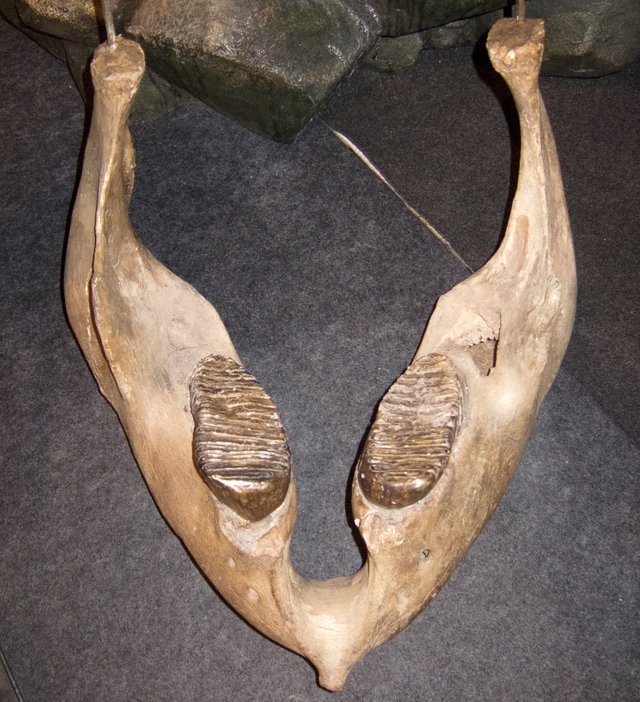
WikimediaThe strong jaws of the woolly mammoth uploaded byFunkMonk AuthorThomas Quine Licenced under CC BY-SA 2.0
Their tusk are normally asymmetrical and varies between them as some have their tusk to curve down rather then outward and some of them having short tusk, for their calves, they develop tusk of few centimeters when they are six months old.
They were known to have four molar, two located at the upper jaw while the other two located at the lower jaw, 23 centimeters of the molar are in the jaw while the other part of the it which is about 2.5 centimeters is above the jaw. Through their lifetime they had six sets of molar teeth which is five replacement in a lifetime, this replacement grew larger more rigid and with more weight, they are known for the most complex molars in the elephant species.
Where You Might Have Found Them
With regards to habitation, the woolly mammoth habitat went across Europe, northern Asia, and parts of North America in the Ice age. Their habitat was called a 'mammoth steppe'. They were also found in parts of Russia where their meal was found to be abundant.
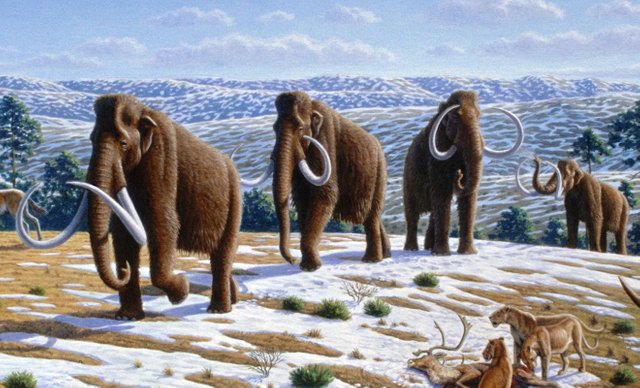
Wikimedia: Author, Mauricio Antón Licenced under CC BY-SA 2.5
These habits were known to have shrubs, herbaceous plants and grasses and trees were, they were not dominated by snow and ice as they were known to be areas of high pressure during the Ice age. Also found in their habitat was animals such as the wild horse, the bison and the woolly rhinoceros.
Woolly mammoth were also said to have been found at Shandong province in China around 33,000 years ago, they were said to have migrated there from Spain where they were also found around that period.
From the analysis of the DNA of the woolly mammoth, it was noticed that there might have been two different species of this animal one being extinct about 45000 years ago, those which became extinct about 45000 years ago were said to have been found in the Arctic region while the other spread through a wide range.
Woolly mammoth fossil have also been found in parts of North America like the South Dakota.
What They Had For Meal
From a discovery of a frozen woolly mammoth which still have some food in its stomach it was ascertained the the woolly mammoth did sustain on plant mainly sedges and grasses supplemented with flowering plants, herbaceous plants, mosses, shrubs and tree matter but generally their food choice is mainly based on their current location. Like the modern elephants, they need varieties of diet to support their growth as an adult woolly mammoth would be seen to consume about 180kg of its diet on a daily base.
WikimediaThe tusk of a woolly mammoth AuthorRept0n1xLicenced under CC BY-SA 3.0
With its two finger tips of the trunk, it picks short grasses, this is done by wrapping it's trunk around them which is different from the modern elephant who curl their trunk about long grasses since they are located in tropical environments.
These trunks can also be used for picking flowers and buds and for also taking leaves and little branches, according to analysis it was confirmed that they only fed on C3 plants.
When trying to figure out what it's calf had for meal, the intestine of a calf was analyzed and in it was discovered milk and faecal matter which might have been eaten to develop its intestine for the digestion of several vegetative plants.
The woolly mammoth might have nursed it's young one for about three years after birth before weaning them from milk gradually introducing them to plant diets from 2-3 years of age, this is less than the elephant which are faced with risk of attack by their predators.
Their dentition were the perfect for these grasses having to chew their food with them assisted with their their strong muscles moving it's mandible forward which sees it's mouth closed and backwards seeing to an open mouth, as the enamel ridges intersects, this see to the cutting and the grinding of the food, these ridges are of a resistant nature which so that the woolly mammoth chewed large amount of food.
Their curved tusk might have been to used to clear snow of the Ice age from the ground so as to get to the vegetations which were buried under the snow and for a drink, they might have broke ice for that, furthermore, it's tusk might have served as aid for digging plants from the ground and stripping back off when needed.
Some Other Features And Behaviors
The woolly mammoths tusk was quite a feature for them, they use them to defend themselves from their predators such as the cave hyenas, the wolves, and the large felines, this tusks was also used for intra-species fights which include fights for territories for the male or fight for mating partners, they also use this to attract females by displaying their large tusks while intimidating their rivals with them.
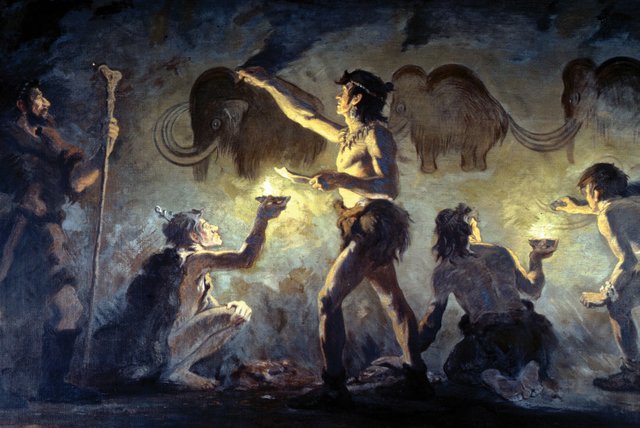
WikimediaArt of man and the woolly mammoth, AuthorCharles R. KnightIs In the public domain under CC BY-SA 3.0
Just like the modern elephants, the woolly mammoth might have been social animals living in small family group,this was suggested by paintings in caves which showed them together in groups hence it was suggested that their other social behaviors might have been of like manner with the modern elephants but it is unknown how many their groups might have consisted of as discovery of their fossil was always of one which had died long time ago.
In Canada, at the St Mary Reservoir tracks made by the woolly mammoth was discovered and this was dated about 11000-11,300 years ago and it suggested that each group might have been made up of same number of adult of different sex, sub adult and juveniles, also, analysis of the path showed that the adult had strides of about 2 m and it's juveniles keep up with them by running.
Their lifespan might have been with respect to size of the mammoth and from the modern elephant which reached about 60 years of age the woolly mammoth might have lived around such. But roughly their males might have lived for 40 years, females 25 years.
Their lifespan sees them loosing their molars in their eruption process loosing the first set of molars about 18 months of age, the third set of molars might have lasted for about 10 years and this repeats till the sixth set, and when they are unable to grow any, they will die of starving since they can't chew anymore.
They might have died mainly during the spring or winter when it hard for the survival of animals of the North.
The Road To Extinction
If you were to take a time travel tens of thousands years back, you would have seen the woolly mammoth roaming the earth leading it's life , but about 10000 years ago, their numbers went on a decrease and 4000 years ago, they became extinct, now the question is asked, what caused the extinction of such wonderful specie. Let's get to what discoveries might have insinuated was the cause of their extinction.
One of the reasons which might have led to the extinction of the woolly mammoth according to scientist might have been climate change, the woolly mammoth was a Pleistocene animal and this period ended just about 10,000 years back seeing the last ice age ending with it. The woolly mammoth amongst other large mammals of the Pleistocene period such as the Sabre toothed tiger which were of quite a population before this period went on a decline.
Thus a suggestion was made that this might have been as a result of climate change which saw the earth heating up bringing a climate which might have been impossible for these animals to coup in.
Another theory brought by scientists was the effect of comes and meteorite which hit the earth, from research conducted, it was discovered that these meteorite might have led to extinction of some large animals of the Ice age, the woolly mammoth included, mostly those in North America.
These asteroid might have caused the melting of ice sheets, wild fires and caused hurricane which reduced their numbers
And Humans gave a big blow.
Another issue which is serious in the extinction of the woolly mammoth is the fact that they were hunted severely by humans which might have been a major factor which led to their decline and at last extinction.
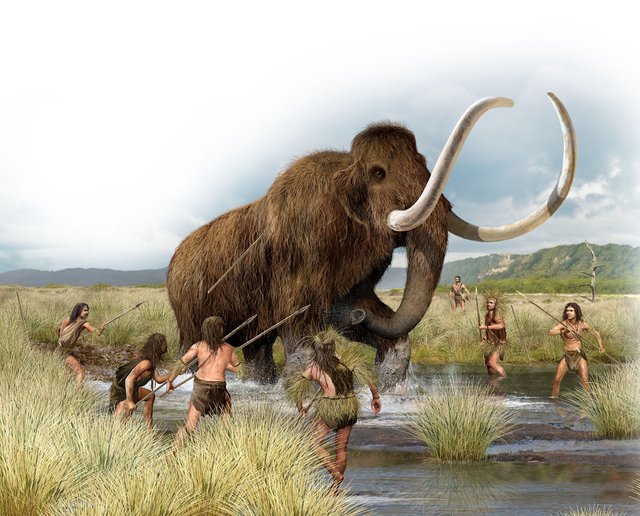
Wiki:Humans at the hunt, Author:Unknown, Uploaded byDaleyhl Licenced under CC BY-SA 4.0
At the end if the Ice age as the temperature change began, this saw most part of the world which was not habitable by humans to become habitable hence humans decided to make habitat of such areas hence having contacts with the woolly mammoth began, this was the beginning of the hunting.
They hunted this animal for its meat, their skin and their bones, discovery of mammoth tusk used in construction confirmed this and according to scientist the combined action of the change in climate accompanied by the hunting by humans created a non survivable earth for the woolly mammoth which at last saw to their extinction.
Concerned Relative - The African Elephant
Scientific Name: Loxodonta africana
Status : Vulnerable To Extinction
The Giants of the forest they are, the elephants are known to be largest animal on the planet having quite large ears which is known to radiate heat to keep them cool, but the heat in Africa is sometimes much so you might find them around waters, spraying themselves.
Their measurement sees the male to range from 3.2-4.0 meters tall at shoulder and weight about 47,00-6,048 kilograms while it's female the range of 2.2-2.6 meters tall and weight range from 2,160-3,232 kilograms but the largest recorded height for an elephant is 3.96 meters and it weighed 10.4 tonnes when measured.
They have such a long nose, their trunks, if which they use for breathing, smelling drinking, trumpeting and grabbing things, most especially meat, this trunks are known for about 100,000 muscles they also features a fingerlike feature towards the end of its trucks of which they use to get hold of little things.
Their diet are mostly of bark, grasses, roots, fruits, they also eat a bunch of stuffs but they can eat up to 300 pounds of their diet in a day, what will you have for something this huge? .
They are known to have less sleep, roaming about from place to place on the search for their large amount of food which they need for their survival, their females move together In herds with young ones while the males may roam on their own. Unlike their Asian relatives, they are not easily domesticated ranging throughout the sub Sahara, West Africa and in the rain forests.
One shocking behavior we know about the elephants is the way they react to the death of their own, do you think only humans grief for their own, then you have to meet an elephant who has lost its own, this was noticed by studying them in the wild.
Are we going to lose the African elephants and tag them extinct just like their relatives the woolly mammoth, I think we all have to do something about their decline and below I have put together some possible threat to them and conservative strategy of which I feel if implemented, their numbers will survive.
Some Threats And Possible Conservation Strategy.
Illegal Poaching For Ivory
Over time the African elephants have been hunted for their ivory, this have led to a very huge decline in their numbers which saw to the ban against poaching on them, but despite the ban on the poaching of the elephants, they are still being hunted and killed illegally bringing their population down.
An estimated tens of thousands of them are being hunted and killed every year by poachers for the need for their ivory tusk, which have been seen to be carved into jewellery and ornaments for their significant symbols of which the market of China is know to be the biggest market for this.
The ban on this was impacted in 1989 by the Convention on International Trade in Endangered Species Of Wild Fauna and Flora, which initially reduced the poaching of this animal as it was before then intense, this allowed the recovery in some places most especially those protected in reserves but recently with the increased demand for this in the Asian market poaching increased and now causing a reduction in their numbers mostly those at the savannah.
Conservation : It was seen that the anti-poaching law saved the African elephants up to an extent but a major reason for this not working positively to the conservation of this animal is the fact that there is a reduction in the anti-poaching capacity of countries, lack of enforcement and increased level of corruption, if all these are addressed, with respect to nations Included on the conservation of the African elephants it will go a long way to save their specie.
Habitat loss and conflict with humans
The African elephants still live in places outside reserves and some activities like deforestation by humans have affected their habitat now their habitat is being lost, this loss of habitat have also seen humans moving into the range of the American elephants leading to a conflict between them and Humans.
The elephants may tend to destroy crops planted by humans and sometimes kill humans in the process and in turn they were killed by these farmers in retaliation and this continue with the growing human population bringing a threat to the survival of the elephants.
Conservation : The issue of deforestation leading to loss of habitat for animals in the wild have affected so many animals seeing them shrink in population, hence we have to put a stop to illegal falling of trees in the wild so as to give them a chance of survival, I think good sensitization of people living in areas close to their range on the vulnerability of the African elephants will go a long way to reduce the conflict and also creating an Avenue for compensation of things destroyed for farmers will see the farmers not retaliating thereby killing the elephants.
Bringing It All Together
It's quite unfortunate that we lost the woolly mammoth amongst other animals which were lost the woolly mammoth, will we say nature happened to them (they might have survived nature, adapted in some form like) or will we attribute their extinction to humans who gave theme a huge blow by hunting them down without care of their numbers, it's a big blow on nature
During the course of this research, I came across some piece which suggested that the woolly mammoth might be cloned back to life by scientists , a possible de-extinction with respect to their found DNA , I believe it's a way forward for the future of science, we humans can achieve anything we set our minds to.
The African elephants which is a concerned Relative to the woolly mammoth have been seen to be on a decline too and this time it's our fault, killing them by the day for valuables without care of their decreasing numbers, some laws have been enacted to protect them by different governments and organizations working to see to their survival. With increased illegal Poaching, they might not survive the blow therfore more still need to be done with regards to the fight against illegal poaching and try as much as possible to protect their habitat.
Its nice having this adventure with you, want to learn about species of animals which have been lost being extinct, a click on the follow button will get you that, have any comments on the woolly mammoth, or the Article in general, let's have a discourse in the comment section, it will be fun.
References
Why the woolly mammoth went extinct
Threats On The African Elephant
This article was brought to you in conjunction with our partner Mechanic Assistant
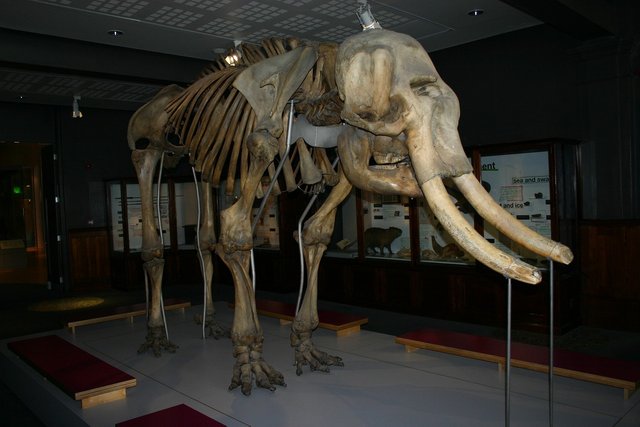
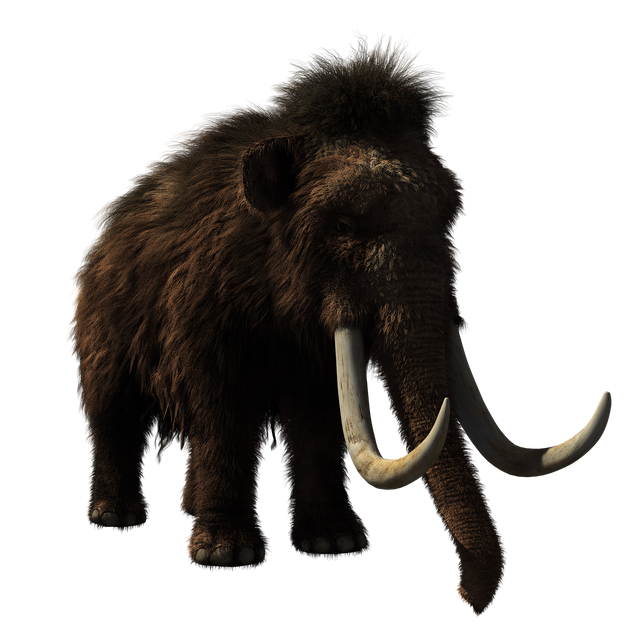
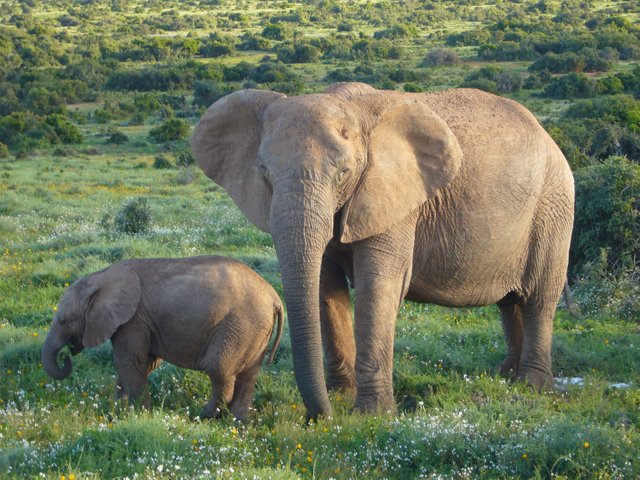
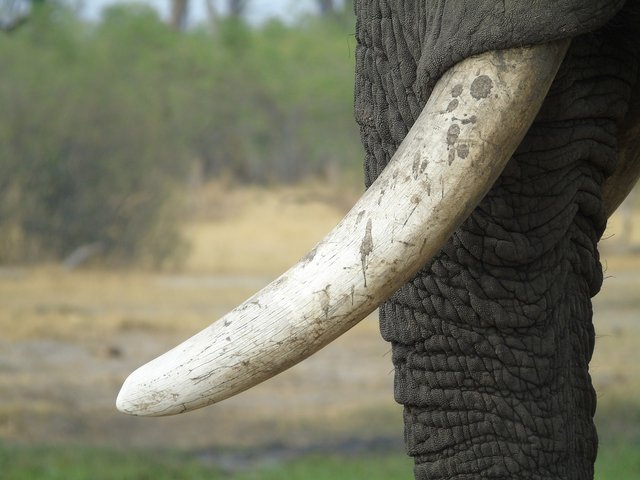
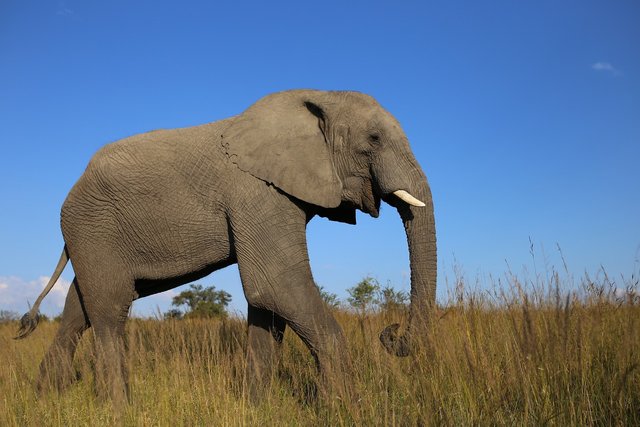
Weren't mammoths twice as big as the elephants?
No they were not, actually when compared with a full sized African elephant, they are a bit smaller, follow this link to see a picture comparison.
That's quite interesting!
Someone needs to acquaint you with the comma 😄
Not good for a cave pet, then.
Thanks @alexander.alexis, will do better at that :)
I never knew the Wooly Mammoth existed until now. I thought it was just a fiction they created in the Ice Age animation series. Thanks for letting me know not only that they existed 4000 years ago but also their adaptive features to the cold environment.
They were amongst the wonders of the Ice age, a body built for the cold. Am glad you found the piece quite educative, nice stopping by :)
Ice age.. And ski safari...that is where i first saw the mammoth.
They roamed the Earth in populations during the Ice Age period , hence appearing in the movie.
Wow.. I guess the movie guys actually did their research well enough. I didn't know they were in the ice age period even while watching those cartoons..
I always felt like they were fictions.
Right @adetola, the movie was quite a hit.
I would also like to see the woolly mammoth bought back through cloning . I have a question, do we need to mix their DNA with ordinary elephant DNA? So the cloned animal would be only eg. 70% woolly mammoth?
There are three approach known to de-extinction, the first involves breeding a living relative to have traits like the extinct animal (this was tried by breeding hairy Asian Elephants) here you won't have the DNA of the extinct animal but traits to fill in gaps in the ecosystem.
The second involves the genetic cloning which you mentioned, inserting the DNA in the egg of close relative, with that an animal with possible 100% identical DNA of the extinct animal might be gotten, but this has to be for a recently extinct animal to work very fine, this saw a goat giving birth to a pyrenean ibex(it later died from a lungs issue though), since it's been long the woolly mammoth went extinct, unsure of the possibility of that working for them.
Lastly is the option which is called genetic engineering (now being tried for them) , here the genome of the extinct animal is lined with that of it's living relative then relevant genes are swaped from the extinct to the living relative with genetic tools and the hybrid genome is grown in an artificial womb, this will not produce genetic identical copies of the extinct animal but a modern version of the engineered animal with traits of the extinct , don't know a percentage though.
I guess that answered your question @flyyingkiwi, nice stopping by :)
Thanks for taking the time to write such a comprehensive answer. So the third option is going to be the best, except for animals that went extinct in modern times. In New Zealand we have one really amazing animal called a Moa. It was a huge bird which was 3.6 m tall. It went extinct only about 600 years ago, so just like the woolly mammoth maybe we can bring them back.
The Moa is quite a beautiful bird, with such amazing size, will be nice if they will be brought back too.
Great post, @logic42! This is a great summary of what we know about the mammoth, as well as the threats to the elephant. Keep up the great work!
Thanks a lot @vault, I appreciate the motivative words :).
This post has been upvoted and picked by Daily Picked #36! Thank you for the cool and quality content. Keep going!
Don’t forget I’m not a robot. I explore, read, upvote and share manually ☺️
Thanks :)
Congrats! Your post was selected to be featured on the steemSTEM Facebook page. If you have a Facebook account, feel free to let us know if you want it tagged so that you can be creditted with the post. Also, be sure to like our page at https://www.facebook.com/OfficialsteemSTEM/.
Thanks for the selection :)
Interesting read i had here. The post is so expository. Thanks @logic42 for this great article. Hope to read more from you
Am glad you enjoyed reading the piece, it's nice of you stopping by, be sure to expect more where that came from :).
The first time i saw a Wholly mammoth was in a game (ski safari) and i thought to myself what kind of an elephant is this i never knew it wasn't an elephant but a wholly mammoth. But in term of their skin thickness compared to any elephant. Which one is thicker??
I really enjoyed the post. Its was an interesting learning adventure indeed. Great work!